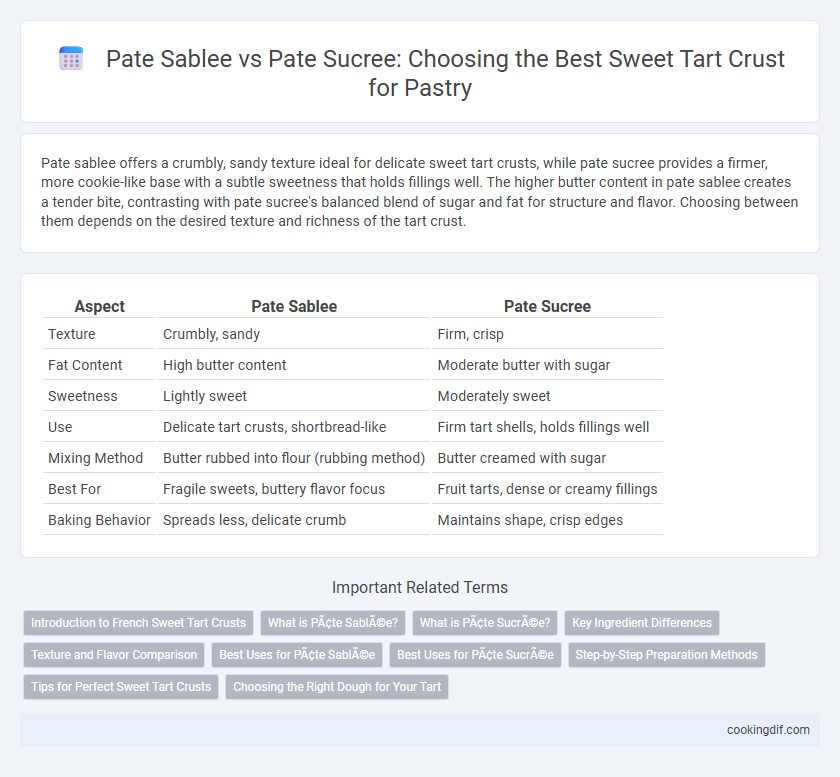Pate sablee offers a crumbly, sandy texture ideal for delicate sweet tart crusts, while pate sucree provides a firmer, more cookie-like base with a subtle sweetness that holds fillings well. The higher butter content in pate sablee creates a tender bite, contrasting with pate sucree's balanced blend of sugar and fat for structure and flavor. Choosing between them depends on the desired texture and richness of the tart crust.
Table of Comparison
| Aspect | Pate Sablee | Pate Sucree |
|---|---|---|
| Texture | Crumbly, sandy | Firm, crisp |
| Fat Content | High butter content | Moderate butter with sugar |
| Sweetness | Lightly sweet | Moderately sweet |
| Use | Delicate tart crusts, shortbread-like | Firm tart shells, holds fillings well |
| Mixing Method | Butter rubbed into flour (rubbing method) | Butter creamed with sugar |
| Best For | Fragile sweets, buttery flavor focus | Fruit tarts, dense or creamy fillings |
| Baking Behavior | Spreads less, delicate crumb | Maintains shape, crisp edges |
Introduction to French Sweet Tart Crusts
Pate sablee and pate sucree are two classic French pastry doughs primarily used for sweet tart crusts, each offering distinct textures and flavors. Pate sablee features a sandy, crumbly texture achieved by incorporating higher butter content and minimal water, ideal for delicate, melt-in-the-mouth tarts. Pate sucree is a sturdier, cookie-like crust with a subtle sweetness, created by adding sugar and eggs to the dough, providing a firm base perfect for holding heavier fillings.
What is Pâte Sablée?
Pate Sablee is a French sweet pastry dough known for its delicate, crumbly texture that resembles sand, achieved by blending cold butter with flour and sugar without overworking the dough. Unlike Pate Sucree, which is more structured and less crumbly due to its higher egg content, Pate Sablee melts in the mouth and is ideal for tender tart crusts with a rich, buttery flavor. Its brittle, sandy consistency makes it perfect for desserts requiring a soft yet crisp base, such as fruit tarts and shortbread-like pastries.
What is Pâte Sucrée?
Pate Sucree is a sweet tart crust dough characterized by its rich, buttery flavor and firm, crisp texture, achieved by creaming sugar and butter before incorporating flour and eggs. Unlike Pate Sablee, which has a sandy, crumbly consistency, Pate Sucree is more structured, making it ideal for holding moist fillings without becoming soggy. This dough is commonly used in French patisserie for tarts that require a delicate balance of sweetness and sturdiness.
Key Ingredient Differences
Pate sablee features a higher butter content and uses sugar granules, resulting in a crumbly, sandy texture ideal for delicate sweet tart crusts. Pate sucree incorporates ground almonds or egg yolks and powdered sugar, producing a sturdier, more cookie-like structure perfect for tarts requiring a firmer base. The key ingredient distinction lies in the sugar type and fat proportion, directly influencing texture and flavor profiles in pastry applications.
Texture and Flavor Comparison
Pate Sablee offers a tender, crumbly texture with a rich, buttery flavor that melts in the mouth, making it ideal for delicate sweet tart crusts. In contrast, Pate Sucree features a firmer, crisp texture with a pronounced sweetness and subtle vanilla notes, providing a sturdy base that holds fillings well without becoming soggy. The choice between the two depends on whether a more melt-in-the-mouth crumb or a crisp, structured bite is preferred for the tart.
Best Uses for Pâte Sablée
Pate Sablee offers a delicate, crumbly texture ideal for tarts that benefit from a tender, melt-in-the-mouth crust such as fruit tarts and creme-filled desserts. Its high butter content and lower sugar level create a rich, buttery base that complements fresh berries and custard fillings without overpowering their flavors. Best used when a fine, sandy texture is desired, Pate Sablee provides a refined balance between structure and tenderness, making it perfect for elegant, pastry chef-quality sweet tarts.
Best Uses for Pâte Sucrée
Pate Sucree, a sweet, buttery crust enriched with sugar and egg yolks, is ideal for sturdy tart shells that hold rich, creamy fillings like chocolate ganache or custard without becoming soggy. Its tender yet firm texture provides a perfect balance for fruit tarts, nutty pralines, and delicate frangipane, ensuring the crust remains crisp during baking. This dough's subtle sweetness complements both fresh and cooked fruit toppings, making it a versatile choice for elegant, refined pastry presentations.
Step-by-Step Preparation Methods
Pate sablee involves creaming cold butter with sugar before gradually incorporating flour, resulting in a tender, crumbly texture ideal for delicate tarts. Pate sucree combines butter and sugar until smooth, then adds eggs and flour to create a sturdier, sweeter crust that holds fillings well. Both doughs require chilling before rolling out to prevent shrinking and ensure a crisp, even tart shell.
Tips for Perfect Sweet Tart Crusts
Pate Sablee offers a crumbly, buttery texture ideal for delicate sweet tarts, while Pate Sucree provides a sturdier, slightly sweet crust perfect for holding moist fillings. To achieve the perfect sweet tart crust, chill the dough thoroughly before rolling to prevent shrinkage and avoid overworking it to maintain tenderness. Using fine sugar in Pate Sucree enhances sweetness without graininess, and blind baking with pie weights ensures a crisp, evenly baked crust.
Choosing the Right Dough for Your Tart
Pate Sablee offers a crumbly, buttery texture ideal for delicate, tender tart crusts, while Pate Sucree provides a sturdier, slightly sweet crumb that holds fillings better without becoming soggy. Selecting Pate Sablee enhances pastries with a melt-in-the-mouth quality, perfect for fruit tarts where a light base complements fresh ingredients. For rich or cream-based fillings, Pate Sucree ensures structural integrity and a balanced sweetness, making it the optimal choice for custard or chocolate tarts.
Pâte Sablée vs Pâte Sucrée for sweet tart crust Infographic

 cookingdif.com
cookingdif.com